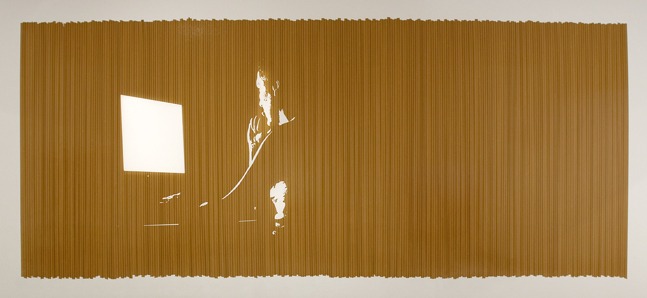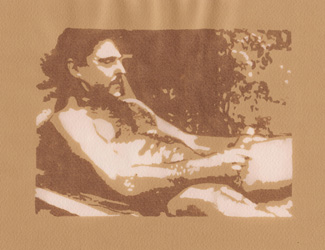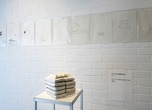The dawn of ‘MAN’
Robert Waters makes a revolutionary Asian debut

‘Man at Computer’ (2008)
Posted: Thu Jul 08 2010
Nakameguro’s Mizuma Action Space, by Mizuma Art Gallery, will be hosting the first Asian solo exhibition by Canadian artist Robert Waters. Waters’s show of both new and previous works, ‘MAN’, will open on Wednesday, July 14.
Waters has been active in the art scene since the mid-90s, and has worked not only in Canada (based in Toronto) but also as far away as Mexico City, Spain, Denmark and England. ‘Waters has a long standing interest in our physical evolution and our intellectual evolution,’ says curator Shai Ohayon. The artist cites themes dealing with the relationships, dynamics and boundaries between physicality, mortality, love, sexuality, time and violence as overarching themes in his work – crafting them into finely tuned riffs and chords on these topics.
‘Man’ features some of Waters’s works from the ‘Clean up your act your dirty faggots!’ series, among new pieces and works that involve performance elements. ‘His art has a very strong visual element and vivid aesthetics,’ which Ohayon posits are aspects that can appeal across cultural boundaries and are also, ‘embedded with layers of meaning and conception.’


One of the hallmarks of Waters’s work is – despite potentially shocking or volatile images or subjects – its approachability. Ohayon says of this inclusivity, ‘My impression is that contemporary art has become more and more alienating and elitist in the last 30 years and, if anything, segregated the art world even further. Waters looks at these issues in a genuine manner and strong ability to communicate,’ and adds, ‘I think that people are charmed by his ability to create work that is witty and full of depth without ever looking pretentious or inaccessible.’

Waters’s openness lies in his methods, which are hands on and even up close with the audience. His work is rife with intensive cutting techniques (as in ‘Killing Saint Sebastian’, a work made of cut velvet and culminating in a performance-like shooting of arrows) or ‘Man at Computer’, which is made from common brown packing tape and depicts a man staring at a computer screen creating a simultaneously raw yet illuminatingly voyeuristic image.
Accessibility of the artwork and the artist’s message is only a small part of the discourse that is meant to be generated through the show. ‘In Tokyo, one of the things that struck me is that much of the work doesn’t have social criticism and is not necessarily concept based. As part of my current efforts is to “open up” the art scene here and to introduce new contemporary art. I felt that Waters’s work maybe suitable to exhibit here [in Japan],’ Ohayon points out.
Waters says of his themes and possible reactions to them, ‘In terms of pushing limits, I do like to be provocative. Playing with lines and limits ends up being about understanding them…It also has to do with ideas of shock – how something unknown can be really disconcerting, but how over time that feeling fades away.’ One of the artist’s most concrete examples of this lies in one of his themes: sex. His aforementioned ‘Faggots!’ series deals with this idea of shock, unfamiliarities and the dissolving of them through the use of images taken from gay pornography magazines from the 70s. The images, which are in their original state potentially shocking for some, are treated with iodine and bleach (sterilising agents) which corrode and fade the image over time – given enough time the image changes radically. Waters elaborates on the idea of ‘fading’ and change in his work, ‘It’s also like the experience of sex, which eventually fades. I’m pretty sure that’s why we keep returning to it.’ Some new additions to the series will be on display along with earlier works in the series, allowing the observer to receive the full effect of Waters’s process.
Two new works exclusive to this show are the previously mentioned ‘Killing Saint Sebastian’ and ‘Jungle Gym’, a two-dimensional sculptural piece done in camouflage fabric. Site-specific pieces include ‘Man at Computer’ and in a similar vein, ‘Are You a Body or Do You Have a Body’ (executed in flesh-coloured surgical tape). Waters’s explains of these mural-cum-pseudograffiti pieces, ‘Doing large work like this really gives the viewer a sense of their own body in relation to the image.’

Mizuma Action Space is in a special position by hosting this exhibition; not only is it a first, but it holds the potential to be a truly revolutionary contemporary art exhibition for the Tokyo art scene. Ohayon muses about the chance for Waters and him to work with such a gallery, ‘I was impressed with their conviction to show work that is edgier and more unusual to Tokyo,’ and goes on to say that it’s a privilege to show with them.
Though some may be tempted to look at Waters’s work as ‘gay’ art, this scope restricts the true parameters of Waters's work and message. Rather, Waters and Ohayon would like viewers of the exhibition to integrate references such as Saint Sebastian (the consummate gay symbol in art) and others into a larger picture that deals with what Waters described as part of the human condition, ‘our problem as humans…that we have a very hard time seeing beyond ourselves and into the future.’ What Waters offers is ‘an alternative, one that will provoke understanding of the viewer’s place and time – which of course is finite too.’
Robert Waters: ‘MAN’
Date: Wed July 14-Sat Aug 14
Time: Tue-Sat 11am-7pm
Location: Mizuma Action Space 5F (Full details & map)
Admission: Free
Website: www.mizuma-art.co.jp/exhibition/e_1276830563.php#robert (English)
Website: www.robertwaters.ca/ (English)
Tweets
- About Us |
- Work for Time Out |
- Send us info |
- Advertising |
- Mobile edition |
- Terms & Conditions |
- Privacy policy |
- Contact Us
Copyright © 2014 Time Out Tokyo













Add your comment